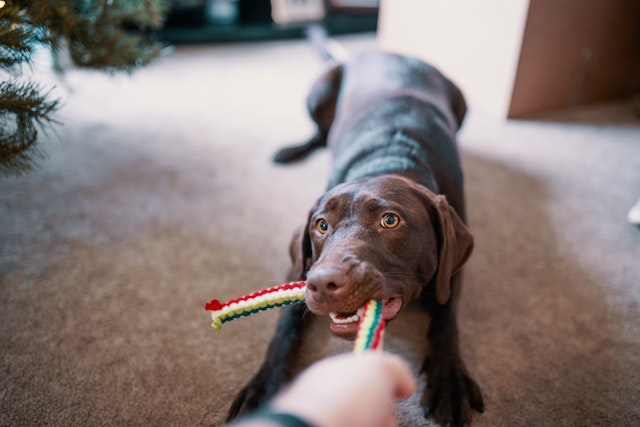10 Common Dog Behavioral Issues
Posted: 01/19/2023 | BY: Jenna Bruce | Categories: Behavior , Dog , Pet care
Dogs are wonderful companions and add a lot of love and joy to your life. But sometimes that love and joy can turn into annoyance and frustration when dog behavioral issues arise.
In this blog post, we’ll cover some of the most common dog behavioral issues and what you can do to fix them so you and your dog can live many happy years together.
1. Nuisance Barking

Dogs communicate through a variety of sounds, including barking. But sometimes the barking can be a bit obsessive and annoy your family and the neighbors!
In order to fix this problematic behavior, it’s important to first understand why your dog is barking so much. No doubt, your dog is trying to get your attention and tell you something. But WHAT exactly are they trying to tell you?
Fix
9 times out of 10 nuisance barking stems from a dog’s boredom or anxiety. And in both of these cases, exercise is the best fix.
Do you ensure your dog is getting enough exercise each day? Letting them out into the back yard once or twice is not ideal. A dog needs physical and mental stimulation and walks are the best way to address both needs.
If you have the time and inclination, it’s also a great idea to spend roughly 10 minutes each day for obedience training. This will stimulate your dog’s mind, mitigating any boredom they may be experiencing.
2. Chewing
Dogs older than 6 months should not have the same need to chew as puppies. If your dog is older and still chewing on everything in sight, it is most likely because of boredom or stress.
Fix
Similar to nuisance barking, if your dog is bored, they may simply lack enough exercise and mental stimulation. Be sure to take your dog on plenty of walks to burn off some of that energy and stimulate their mind.
You also want to be certain you provide your dog with a variety of chew toys and mental games. Be wary of rawhide chews as many dogs have choked on these or have developed life threatening blockages in their GI tract. Offer Nylabone types of chew toys and others that are safe. And as always, ask your vet what they recommend.
3. Territorial Behavior
Dogs are territorial by nature but certain breeds have an even stronger territorial instinct. If not nipped in the bud during puppy training, this instinct can lead to threat barking and aggression in some dogs.
Fix
If your dog barks when there is a reason or a perceived threat in his territory (your home), praise him for this initial response. Afterward, tell him to sit and redirect his territorial energy into a new thought pattern or activity they may enjoy. If your dog is older and has been displaying this behavior for a while, understand that it may take weeks or even months before you can change this unwanted behavior. Be patient with your dog. They aren’t intentionally trying to frustrate you.
Beware of Stress Barking
Human beings, being what we are (fallible), can often misunderstand why our dogs are doing what they are doing. Often when dogs bark because there is a threat in their territory (the FedEx guy outside), a pet parent will instantly become annoyed and yell at their dog. This will cause stress in your dog.
What if someone yelled at you every time you inhaled or exhaled. You would eventually become really, really stressed out. Well territorial barking is as natural and instinctual to a dg as breathing is to us. If you constantly reprimand your dog for doing something that is completely instinctual, it will confuse the heck out of them and eventually stress them out.
That’s why initially it is very important that you praise them for their behavior. After all, they are doing their job and trying to protect you from the DoorDash guy. Once you praise them, get them to sit and calmly give them the “quiet” command. If you haven’t taught them this command, now’s the time to start.
4. Toy Aggression

This is one of the most common dog behavioral issues. A lot of poor behavior from dogs is caused by pet parents not taking on a leadership role. To be the “alpha” dog in your home means to be confident and calm. To be able to remove a toy from your dog’s possession will require you to be a leader. Shouting or yelling at your dog when they show any aggression will most likely only make them more defensive. And begging your dog to let go of the toy will only prove they are the alpha, not you.
Fix
When your dog is playing with a toy, approach him in a slow and calm manner. Never show threatening body language or make eye contact when removing the toy. Simply speak calmly and slowly remove it.
5. Jumping Up on People
When dogs get super excited meeting new people, they tend to jump up on them. This is problematic for obvious reasons, not the least of which is that not everyone is a dog person. Your new neighbor, who is wearing her nice dress pants, will most likely not appreciate your dog jumping up on her to offer an enthusiastic “hello!”
Fix
You’ll need to train your dog to meet new people. Start by having them sit calmly next to you. Then have the new person approach the two of you. Each time your dog gets up excitedly, have them sit back down. Have the person walk up to you again. As many times as your dog gets up excitedly, you’ll need to start the process all over again until they remain seated. Once he remains seated, the person may approach fully. Be sure to praise your dog when he finally remains calm.
6. Pulling During Walks

If you let them, most dogs are happy to lead their humans on walks. If you find yourself behind your dog, and they are pulling you here and there, it’s time to gain control.
Fix
A little obedience training will help your dog learn the HEEL command. This will teach your dog to concentrate on you during the walk instead of every trigger in the environment. Practice making your dog HEEL on a walk, that is, pay attention to you, and then also release him from the HEEL and let him freely sniff and explore. This will give him the freedom he needs while also giving you the ability to “snap” him back to attention and back to your side in an instant.
7. Housebreaking Fails
It’s simply not realistic to think your puppy will become potty trained overnight. Puppies take a bit of time to grow into adult dogs who can control their bathroom needs. Having said this, there are things you can do to help your puppy have more successes than failures.
Fix
Establish a bathroom schedule and stick to it as closely as possible. Your dog needs to learn that he or she can rely on those times throughout the day when they can get outside and relieve themselves. The better you are at sticking to a tight schedule, the better able your dog will be to follow it.
Get up early. You can’t expect your puppy to hold it all night and into the afternoon because you feel like sleeping in on Saturdays. Get up nice and early and take your puppy out first thing.
Be sure to praise your dog right after they relieve themselves outside in the designated area. This positive reinforcement will teach your dog to stick to the potty routine.
Never scold your dog when they have an accident inside. They are not doing it intentionally. Your puppy may have four great days in a row and then something will happen. They may have become frightened during the night and had an accident. Never yell, simply clean the area thoroughly with an enzymatic cleaner to remove the smell entirely.
8. Digging

This is another one of the most common dog behavioral issues. Many dogs are diggers and can leave your backyard looking like an archeological expedition. Before you can fix this unwanted behavior, you need to know why your dog is digging in the first place.
For instance, some dogs dig because they have a strong prey instinct. They want to get at that chipmunk. Other dogs dig holes when they are hot to lie in and cool off. Some dogs dig because their sense of smell is incredibly strong and they are simply curious what it is they are smelling way down there. And still others dig for a lack of exercise and stimulation.
Fix
If your dog is digging because they need someplace cool to lay, be sure to provide plenty of shaded areas in the backyard, or do not leave them back there for any length of time during hot days. If they have an acute sense of smell, like beagles do, they will need to be mentally stimulated to exhaust their urge to dig.
If your dog is digging to get at prey, they will need to be leash trained to get them to stop.
And if your dog is digging from boredom, then they will need to be walked and perhaps even enrolled in obedience training for mental stimulation.
9. Herding Instincts And Nipping At The Heels
Cattle dogs, Australian Shepherds and Border Collies are all herding dogs, which means they were bred to help ranchers herd their cattle. There are other dogs that have also been bred with this instinct. When these dogs become house pets with nothing to do all day, they begin to herd their people, especially young children. Sometimes they may even nip at heels or grab a child’s sleeve to lead them away from danger. While their intention is good, the behavior can scare a small child and be annoying to adults.
Fix
If your dog has any herding breed in them, they will greatly benefit from the mental stimulation that agility training offers. Try and find agility courses and training in your area or ask your vet if they can recommend someone.
10. Separation Anxiety

Oftentimes we fall in love with dogs that have had a rough start in life. When these dogs are not properly socialized, have been neglected or abused by people, or have roamed the streets as a stray, they develop separation anxiety. When left alone, dogs with separation anxiety have a panic response, which can cause them to destroy your furniture and even doors, counters, etc.
Fix
Crate training can be incredibly beneficial in these situations. Your dog’s crate is his “safe zone,” and when in his crate, he should feel safe and secure, even when left home alone. If you haven’t crate trained your dog, now is the time to start.
You may also want to look into using something called Adaptil, or DAP for short. This is a synthetic pheromone that mimics a dog mother’s calming pheromones. Many dogs are calmed by using DAP.
And finally, speak with your vet. Depending on the severity of a dog’s separation anxiety, they may require prescription medication to keep them calm during those times their humans are away from home.
Sometimes Pros are Needed
In many cases, pet parents can stop dog behavioral issues themselves. But it’s important to mention that every dog is different. Some may easily respond to redirection while others may be far more challenging.
If you have a dog who seems to fall into this ‘challenging’ category, then it’s a good idea to call in the help and expertise of a professional dog obedience trainer. At the end of the day, you want your training experience to be safe and effective for both you and your pup. Bringing in someone who really knows how to handle challenging situations and behavior may be the best way to go.
It’s a good idea to speak with your vet to see if they can recommend a trainer in your area who specializes in dog behavioral issues. If they don’t, speak with your groomer or any other pet parent you may know to get a personal recommendation. Not all trainers are good, so you want to be sure you select someone that has a great reputation and is trusted by people you yourself trust.
Get Insurance You Can Trust
Redirecting dog behavioral issues is necessary so your dog can live a happy life. You know what else is necessary? Great health!
But no matter how hard we as pet parents try and ensure our dogs are healthy, accidents and illnesses happen. And when they do, those vet bills can add up to thousands of dollars. Are you financially prepared to take on those bills?
A pet insurance plan helps you to give your beloved pup the care they need when they need it while also giving you and your family peace of mind.
Take a minute and get a free quote from one of the top insurance providers in the country.
References:
- “Common Dog Behavior Issues,” Retrieved from: https://www.aspca.org/pet-care/dog-care/common-dog-behavior-issues
- Stregowski, J., (2022) “10 Common Dog Behavior Problems and Solutions,” Retrieved from: https://www.thesprucepets.com/common-dog-behavior-problems-1118278
- Flowers, A. DVM, (2021) “Top 12 Behavioral Problems in Dogs,” Retrieved from: https://pets.webmd.com/dogs/ss/slideshow-behaviorial-problems-in-dogs
The information contained on this blog is intended for informational and educational purposes only and should not be construed as medical advice. It is not a substitute for professional veterinary care. Always consult with your veterinarian before making any changes to your pet's health care or treatment plan.
The authors of this blog are not veterinarians and do not claim to be experts in pet health. The information provided here is based on our own experiences and research, as well as information from reputable sources. However, we cannot guarantee the accuracy or completeness of this information.
We encourage you to do your own research and consult with your veterinarian before making any decisions about your pet's health.
Previous post
National Unchain a Dog Month: Our Best Friends Need UsNext post
Common Cat Behavioral ProblemsCompare top pet insurance providers plans.
Enter your dog’s age in years and months to calculate their age equivalent to human years.
Calculate your dog’s ageEnter your cat’s age in years and months to calculate their age equivalent to human years.
Calculate your cat’s age